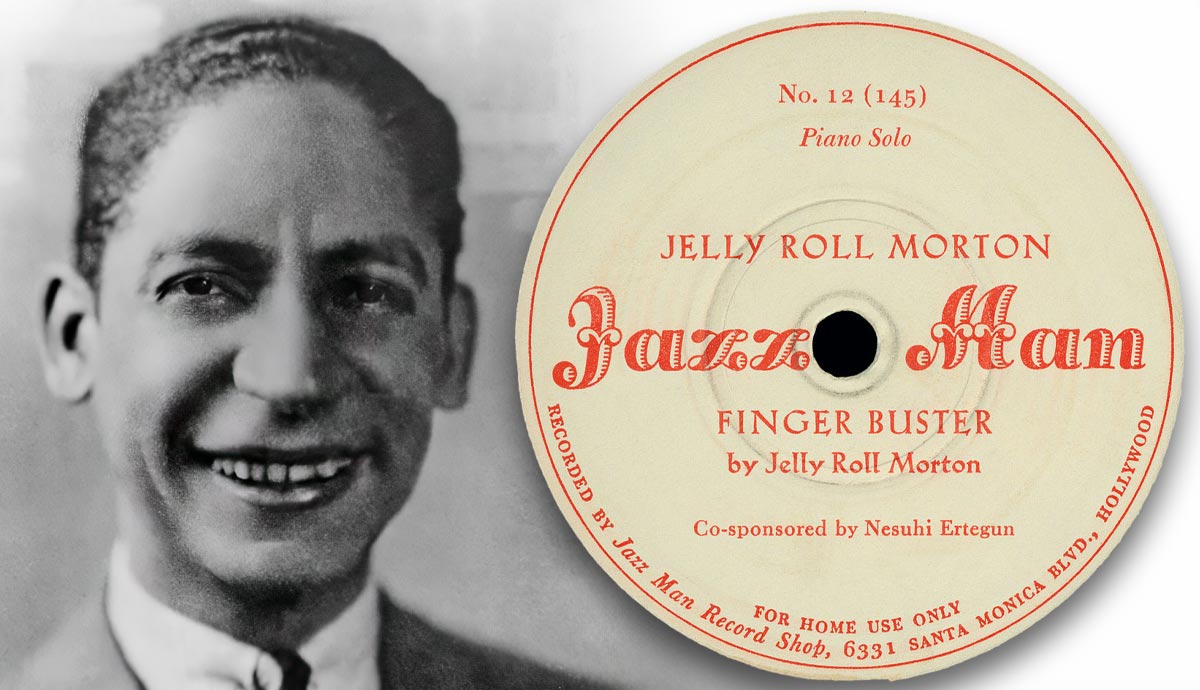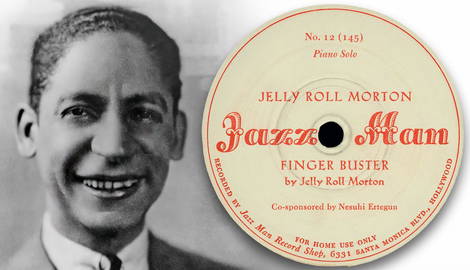
Self-styled inventor of jazz, pianist, bandleader, composer, hustler, vaudeville show entertainer, rumored pimp. Ferdinand “Jelly Roll” Morton published the first recognized jazz music, “The Jelly Roll Blues,” in 1915, and with his band Red Hot Peppers, recorded some of the most distinguished music in the history of jazz. In his later years, he ran a nightclub in Washington DC and was stabbed in the neck. In 1938 he recorded his life story—and his history of jazz—for the Library of Congress. The story of Jelly Roll Morton is a tall tale of musical genius, the spirit of New Orleans, and the invention of jazz.
Jelly Roll Morton: From Storyville to Vaudeville

Ferdinand Joseph Lemott (LaMothe, or LaMenthe) was born between 1885 and 1890 in New Orleans, Louisiana. Both his parents were among the free people of color, Creoles, whose ancestors arrived in Louisiana after the Haitian Revolution. His father left when he was three. After his mother remarried, he took his stepfather’s name, anglicized it to “Morton,” and shortened his forename to “Ferd.” He began learning the piano at ten years old.
Before long he was gracing the red light district of New Orleans—Storyville—with his music. He played piano in the district’s brothels all times of the day, learned from old-time New Orleans players, and experimented with musical styles and techniques until he rose to become the leading piano player in the district.
Above all, Ferd Morton was a musician, yet he rubbed shoulders with the “tough babies and sweet mamas,”—the gangsters, gamblers, and sharks of Storyville—and moved freely among them.
Between 1907 and 1917 he left New Orleans to work in vaudeville (a form of light entertainment akin to cabaret) as a pianist and singer. He joined Will Benbow’s traveling vaudeville show as a pianist, and on the side played the locals at pool. Morton’s strategy was clear: after playing dumb for a while “until the bets rolled up high” he proceeded to “clean them out” (Lomax, 1950, p.113).
It was around this time, during a performance with Benbow’s show that he acquired the nickname “Jelly Roll.” Morton fancied himself as a comedian as well as a pianist and would sometimes “black up” and perform a routine. During an exchange with another comedian on the show who introduced himself as “Sweet Papa Cream Puff,” Morton retorted that he was “Sweet Papa Jelly Roll” — black slang for female genitalia, but also a common nickname at the time for smooth, flashy types such as Morton.
The Birth of New Orleans Jazz

Jelly Roll Morton’s claim to have “invented” jazz has often been largely removed from the context in which he said it. For now, it will suffice to say that he was one of the most important figures in the history of early jazz — and a pivotal figure in the emergence of the New Orleans Style.
The roots of jazz date to approximately 1900 and can be traced to various regions across the United States: the ragtime piano of Scott Joplin in St Louis Missouri, and the stride piano of James P. Johnson in Harlem, New York. In the southeast United States, a local piano style based on ragtime and Appalachian gospel music also emerged around the same time.
Thus jazz was not simply the preserve of New Orleans. While the likes of Jelly Roll Morton, Buddy Bolden, and Louis Armstrong were jamming jazz in Storyville, African and European musical ideas were also coming together in other parts of the United States. New Orleans was nonetheless of particular significance in the history of the music.
Thanks to its Catholic-Mediterranean culture of parades, festivals, and fraternities, New Orleans became a cradle of jazz experimentation. The New Orleans jazz style grew out of diverse elements: the Voodoo drum dances of Congo Square, Afro-Spanish rhythms of the tango and habañera, Protestant gospels and spirituals, European classical music, and the Mississippi country blues.
After the Civil War, the traditional slave culture of the city broke down and a much less inhibited mix of European, Creole, and black musical idioms began to merge in the streets, parades, and brass bands of the city. In Storyville, above all, New Orleans jazz was born.
Library of Congress Recordings

Morton’s journey through the world of show business began when he was a child. But he also worked various blue-collar jobs, he was a tailor, a cosmetics salesman, and a boxing promoter. Nonetheless, from an early age, he crafted his persona meticulously. Jelly Roll Morton dressed to impress, talked the talk, and walked the walk.
In the summer of 1938, flat broke and almost finished, Morton was recorded by Alan Lomax at the Library of Congress. According to Lomax, “he came to the library with some friends of his who know him, and said that he wanted to correct the history of jazz.” Dressed in a pristine suit, with a matching shirt and printed silk tie, a watch fob, and gold rings, the self-styled “originator of jazz, stomps, and swing” proceeded to deliver the story of his life and his history of the birth pangs of jazz.
Sat at the grand piano in the chamber music auditorium in the Library of Congress, Morton held court, with Lomax sat at his feet with a pair of Presto disk recording machines. He accompanied himself as he laid down his definitive musical history of New Orleans jazz, shifting to minor keys when his stories demanded it, and flashing the half-carat diamond set in gold in his front tooth when he smiled.
The results were remarkable. In just over eight hours of recordings, Morton recounts the stories of Storyville, the institutions, festivals, funerals, and rituals of New Orleans, underworld characters, the players that were never recorded, and the different types of music that he heard played in the city. Taken together, Morton’s interviews are one of the finest oral history documents about the history of music and culture of a city ever made.
Jelly Roll’s Jazz

Jelly Roll Morton didn’t “invent” jazz. However, his innovative combination of ragtime, blues, European classical, and African-rooted New Orleans street music, with a “tinge” of the Spanish Caribbean, marks him out as one of the defining figures of this early revolution.
In 1915, Morton achieved a significant milestone as the first officially published jazz composer with his seminal “Jelly Roll Blues.” Yet it is important to note that he never exactly claimed that he invented jazz, he contended that he was the first one to transform exceptional music into jazz (Szwed, 2005). He described jazz as a “style that can be applied to any type of music.”
Morton criticized the “stiffness” of the ragtime players and dismissed the blues pianists as “one tune players” — yet his own “hot” jazz expertly combined the formal precision of ragtime piano with a deep respect for the blues. He was one of the first jazz pianists to “season” the rich harmonic textures of the blues with Afro-Spanish rhythms such as the tango and the habañera.

Beyond music styles, jazz, for Morton, was a fine art — and he was a pianist and composer of the highest order. Jazz, Jelly claimed, was at heart a style inspired by “ideas drawn from operas, symphonies, and overtures.” For him, there was “nothing finer than jazz music, because it comes from everything of the finest class music” (Szwed, 2005).
Of all his recordings, his early sessions in Chicago with the Red Hot Peppers (1926-27), and the likes of his King Porter Stomp, Wolverine Blues, Grandpa’s Spells, and Jelly Roll Blues are generally considered his greatest achievements. In 1998, Jelly Roll Morton was inducted into the Rock and Roll Hall of Fame, and his Library of Congress interviews, released in 2005 as a box set, won the award for Best Historical Album and Best Liner Notes (2006). That same year, he was posthumously honored with the Grammy Lifetime Achievement Award.
Highs and Lows

The greatest period of Jelly Roll Morton’s career was as pianist and bandleader of the Red Hot Peppers, between 1926 and 1930. Featuring some of the best New Orleans-style musicians around, such as Johnny Dodds (clarinet) and Johnny St Cyr (Banjo/Guitar), the Red Hot Peppers set the standard for small jazz bands. The band signed to the Victor Company and proceeded to record some of the finest recordings in the “hot” New Orleans style ever made.
Though he would never admit it, the 1929 Wall Street Crash and its aftermath dented Jelly’s prospects. As the Great Depression tightened its grip, in 1930 Morton and his wife Mabel Bertrand arrived in New York and soon ran into trouble. The Red Hot Peppers disbanded and Morton struggled to find musicians who wanted to play his “old fashioned” music — as the young Harlem jazz musicians called it.
His fortunes continued to plummet. Struggling to make a living, in 1935 Morton deserted his wife and left New York for Washington to try his luck as a boxing promoter. It didn’t work out, and instead, he wound up running a small nightclub called The Music Box.
A glimmer of hope came as a revival of interest in New Orleans jazz led a stream of predominantly white jazz critics and fans to The Music Box to witness the famous Jelly Roll Morton in action. However, tragedy struck in 1938 when he was viciously stabbed in the head and chest while seated at the piano by a disgruntled customer he had gotten into an argument with moments earlier.
He survived and for a time, made efforts to mount a musical comeback, but he was not a well man. In the aftermath of the attack, Jelly Roll developed serious breathing and heart problems that eventually, in 1941, claimed his life.
The Enduring Legacy of Jelly Roll Morton

While the origins of Ferd “Jelly Roll” Morton are shrouded in mystery (his actual last name is unknown, and his date of birth is unclear) he is without doubt considered among the all-time greatest jazz musicians and most influential musicians and composers of the New Orleans style.
Morton didn’t “invent” jazz but he was a master of jazz. Central to Jelly Roll Morton’s legacy are the groundbreaking recordings made with the Red Hot Peppers between 1926 and 1930. Yet, despite their significance, Morton enjoyed very little commercial success in his lifetime. He failed to copyright his original music, claim rightful royalties, and most importantly, attain due recognition for his seminal contributions to jazz.
He was left embittered and largely overlooked in his lifetime. Ironically, just as a revival of New Orleans Jazz was taking off in the early 1940s—and Jelly himself was being rediscovered—he died of respiratory problems stemming from the wounds he sustained in 1938. His premature death at 50(?) was tragic.
As a composer, Morton was an early architect of the jazz form. He was the first to codify the improvisatory nature of jazz into a published form, featuring distinct sections, solos, and breaks that became standard elements of later jazz arrangements. His invaluable testimony at the Library of Congress stands as the cornerstone oral history document of the history of New Orleans Jazz, a significant cultural artifact in the cultural history of the United States.
Jelly Roll Morton was a true innovator of jazz and directly influenced some of the greatest of the later generations of jazz pianists, such as Earl Hines and Art Tatum. His imprint is undeniable. Above all, Jelly Roll Morton’s remarkable music endures, offering future generations the opportunity to savor, appreciate, and enjoy.









